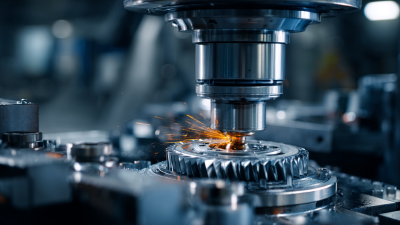Exploring the Essentials of Auto Mechanical Engineering Processes
In the rapidly evolving field of auto mechanical engineering, understanding the fundamental processes is crucial for both aspiring engineers and industry professionals. According to a report by the Bureau of Labor Statistics, the employment of automotive service technicians and mechanics is projected to grow by 4% from 2019 to 2029, reflecting the continuous demand for skilled practitioners in this sector. This blog will delve into the essentials of auto mechanical engineering processes, offering valuable insights and practical tips that can enhance both efficiency and innovation in automotive design and repair. As vehicles become increasingly sophisticated with advanced technologies, a solid grasp of mechanical engineering principles remains indispensable. By exploring the interplay between traditional practices and modern advancements, we will provide readers with a comprehensive overview that will empower them to navigate the complexities of auto mechanical engineering effectively.

The Significance of Alternative Materials in Auto Mechanical Engineering
The automotive mechanical engineering sector is undergoing a significant transformation, particularly with the increasing significance of alternative materials. Nylon, recognized for its strength and elasticity, plays a crucial role in various automotive components, offering the durability needed for modern vehicles. The demand for nylon and other engineering plastics has been on a steady rise, with the market showing an annual growth rate of approximately 3.52% from 2017 to 2023. This upward trend indicates not only a growing reliance on these materials but also a shift toward lightweight and more efficient automotive designs.
Moreover, the introduction of advanced materials such as PEEK has generated considerable interest within the industry due to its exceptional properties, including heat resistance and lightweight characteristics. As automotive manufacturers strive for improved fuel efficiency and reduced emissions, the use of such innovative materials is becoming essential. As the market evolves, companies are increasingly investing in research and development to optimize the performance of these alternative materials, ensuring they meet the rigorous demands of the automotive industry while fostering sustainability and economic efficiency.
Innovative Manufacturing Techniques: Alternatives to Traditional Processes
The landscape of manufacturing is shifting dramatically as innovative techniques emerge as viable alternatives to traditional processes. One prominent area of growth is in the realm of additive manufacturing, which increasingly offers environmentally friendly options that can reduce waste and energy consumption. The ability to create intricate designs using methods like 3D printing not only streamlines production but also opens the door to sustainable practices, aligning perfectly with the rising demand for eco-conscious manufacturing.
In parallel, industries such as pulp and paper are embracing transformative technologies driven by sustainability goals. These advancements are not limited to traditional sectors; even agriculture is experiencing a revolution through the integration of cellular agriculture and 3D food printing, paving the way for sustainable, animal-free dairy products. This synergistic approach to innovation highlights how various sectors can learn from each other, adopting methods that enhance efficiency and reduce environmental impact.
As these alternative manufacturing techniques continue to evolve, they redefine the very foundations of production, offering a glimpse into a more sustainable and innovative future.
Sustainable Practices in Auto Mechanical Engineering: Exploring Green Alternatives
In the ever-evolving field of auto mechanical engineering,
the integration of sustainable practices has become a pivotal concern. As the automotive industry faces mounting pressure to reduce its environmental impact, engineers are exploring green alternatives that not only preserve natural resources but also enhance vehicle performance. One of the most significant shifts has been the adoption of lightweight materials, such as aluminum and advanced composites. These materials not only improve fuel efficiency but also contribute to lower emissions throughout the vehicle's lifecycle.
Additionally, the incorporation of renewable energy sources into engineering processes is gaining traction. Practices such as utilizing solar power for manufacturing facilities or harnessing wind energy to power assembly lines exemplify how sustainability can be woven into the fabric of auto manufacturing. Moreover, innovative waste management strategies are being implemented to minimize waste generation and facilitate recycling efforts, ensuring that materials are reused or repurposed rather than ending up in landfills.
By emphasizing these green alternatives, the auto mechanical engineering sector is taking significant steps toward a more sustainable future, aligning with global environmental goals.
Emerging Technologies in Alternative Automotive Engineering Solutions
The automotive industry is undergoing a significant transformation driven by emerging technologies that offer alternative engineering solutions. Innovations such as electric and hybrid vehicles are reshaping traditional automotive mechanics, encouraging a shift towards sustainable practices. These technologies not only enhance fuel efficiency but also reduce the overall carbon footprint of transportation.
When considering the shift towards alternative automotive engineering solutions, staying informed is crucial. One useful tip is to continuously educate yourself on the latest advancements in electric vehicle technology, battery management systems, and autonomous driving features. Online courses, webinars, and industry conferences can provide valuable insights to effectively navigate this evolving landscape.
Additionally, embracing simulation software can streamline the design and testing processes of new automotive systems. This technology allows engineers to run virtual tests, minimizing physical resource usage while enhancing precision and productivity. It is a critical tool that can significantly aid in faster development times and improved product performance. Exploring these emerging technologies not only becomes a necessity but also opens the door for innovation in automotive engineering.
Emerging Technologies in Alternative Automotive Engineering Solutions
The Impact of Digitalization on Alternative Engineering Methods in the Auto Industry
The automotive industry is undergoing a revolutionary transformation as digitalization reshapes traditional engineering methods. A report from Deloitte highlights that nearly 60% of automotive manufacturers are investing in advanced digital technologies, with a focus on Design and Manufacturing 4.0 strategies. This shift is not merely a trend; it is a necessity to stay competitive in an increasingly global market. Digital tools enable engineers to simulate and optimize designs through advanced modeling techniques, reducing development time by up to 30%, which is critical in an industry where speed to market can determine success.
Moreover, the integration of technologies such as AI and IoT in automotive engineering processes has a profound impact on efficiency and innovation. According to McKinsey, automotive companies leveraging these technologies can reduce production costs by approximately 20% and improve quality by identifying potential defects in real time. For instance, virtual prototyping and 3D printing allow for rapid testing and iteration of components, accelerating the overall production cycle. As the industry moves toward electric and autonomous vehicles, the adaptability provided by digitalization will be key in enabling manufacturers to respond swiftly to evolving market demands and technological advancements.
Related Posts
-

The Future of Best Mechanical Manufacturing Innovations and Trends
-

How to Choose the Right CNC Precision Engineering Solutions for Your Business Needs
-

Addressing the Key Challenges in the Performance of Civil Engineering Machines: A Data-Driven Approach
-

The Ultimate Guide to Discovering the Best Engineering Solutions for Your Business Needs
-

Comparative Analysis of Civil Engineering Machines Efficiency in Modern Construction Projects
-

The Evolution of Civil Engineering Machines Shaping Tomorrow's Infrastructure
